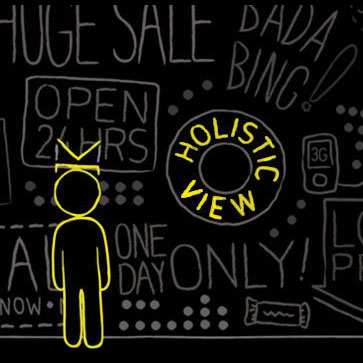Need Better Leads? Ask a Conversion Optimization Whiz

If you're looking for an edge (and who isn't) check out Website Magazine's interview of Jeremy Leonard, the SVP of Strategy and Operations at digital media agency MediaWhiz and a real whiz when it comes to conversion optimization.
Numerous well-known names fill the MediaWhiz client roster including Nielsen, Home Depot, Discover and many others - and Leonard's experience with these brands and their challenges shines through in the interview below, providing Website Magazine readers with compelling insights into high-level lead generation and conversion optimization, some guidance on the debate over form length, and how traffic quality and mobile devices are forcing advertisers to shift their approach quickly.
JL: Great question with several compelling answers:
Everyone should be concerned with conversion optimization for a very simple reason: consumer traffic to your website isn't free. Even if your site traffic is coming from SEO or Facebook "Likes," you spend time and money to generate that traffic. Marketers should naturally demand a return on that investment. That ROI should be in the form of consumers completing a specific call-to-action. In the world of lead generation, that call-to-action will be in the form of a qualified lead or sale.
Some advertisers may look at lead generation specifically and think, "Well, I'm only paying a publisher for a lead - why would I need to go to the trouble of making a site optimize properly? I don't pay for anyone who doesn't convert." This couldn't be further from the truth. Performance-based lead generators have hundreds of advertising offers that they can run to their display inventory, drop to their email lists or make SEM bids. The offer represented by your website is no better than if the publisher can't generate a fair return on its media investment.
Poorly converting sites will result in a high number of clicks but a low number of leads; this instantly tells the publisher that the problem is not with its traffic but with your site. Your offer will be taken out of rotation, and you will be lucky if anyone sends traffic to your site again.
JL: The "short-form" vs. "long-form" debate has existed since advertising began. Hammurabi's code from Babylon was long-form. Moses' 10 Commandments were short-form. They both served their purpose.
The first guidance I would give anyone making the decision regarding whether to use short-form vs. long-form in relation to conversions is to not make the decision. You will never understand your consumers as well as they know themselves.
My recommendation is to develop two separate buy flows, then put them in Google Optimizer and start testing.
Short-form, of course, requires immediate remarketing through a call center, SMS texting or an auto-responder email to complete the process. Although this does require additional effort on the part of the marketer, you will gain great insights by running these campaigns in parallel. One of the most powerful insights you will gain are the conversion rates at different points in the decision making process. For instance, if you have 30 percent of your consumers completing the short-form, then 80 percent of those same consumer's being "closed" through immediate remarketing, your conversion rate is 24 percent.
If your long form has a conversion rate of 22 percent it would seem initially that the short form is the way to go. However, due to cost reasons associated with closing the short form, you may well be willing to give up the 2 percent differential to avoid the remarketing costs.
Finally, think about your product - does a consumer "need" it or do they "want" it. The more a consumer "needs" your product (a loan or a job) the more they will be willing to walk through a long form. The more a consumer "wants" your product (an insurance quote, a coupon) the less willing they will be to walk through a long form.
JL: From our experience, we see 20 - 30 percent of lead-gen traffic via mobile devices. If you aren't set up to capture that traffic, you are throwing money away. So how do you go about capturing mobile leads? Here are a few ways:
1. A "warm transfer" program. this involves a short form (name, email, cell phone) and button that has call-to-action along the lines of "call me now." when user presses button, third-party vendor, such as ringrevenue, posts lead to call center initiates from operator consumer. at point, will complete lead-generation script post full lead.
2. An SMS or email auto-responder. If using a call center isn't in the plan, then you can change the call-to-action on the button to something like "Send me more Info Now." At that point, the advertiser can either send an SMS message with a link directly to the phone or send an email to the user.
3. Personally, I am not a big believer in QR codes unless the payoff for the consumer is significant. QR codes are like a long joke - the longer the joke, the better the punch line needs to be. If, as an advertiser, you can provide a big punch line, then use QR codes. Otherwise, stay away from them.
4. Finally, create mobile content that people want to share. Whether someone posts from their phone to Facebook, tweets it or simply emails it to a group, provide an incentive to the consumer to share.
JL: Simply put, good leads don't come from bad traffic.
While there is certainly plenty of " bad" traffic out there, more frequently there is "inappropriate" traffic. for instance, it wouldn't make sense to send a lead-gen campaign luxury car sub-prime finance consumers. simply bad match.
The more often an advertiser can tell his media partners something about the demographics and psychographics about his consumers, the better chance that the media partner can find "appropriate" traffic.
Once the right traffic is coming in, an advertiser still needs to focus carefully on affiliate ID numbers or sub-ID numbers, which convert to sales. Traffic that comes from SEM will almost always convert at a higher rate than email traffic because the consumer is in a buying frame of mind. Focus on the high-converting traffic and be willing to pay more for it. Be prepared to simultaneously cut your price for the low-performing traffic. Drive all of your traffic toward a pre-determined cost-per-action - whether that action is a sale, a request for information or a download.
Once you have "appropriate" traffic that is prices right you can begin to optimize a site for conversions; sites are inherently optimized around consumers that have a propensity to convert. Once "appropriate" traffic is coming to the site, only then can a site be optimized through many of the standard steps of A/B testing and multivariate testing.
Are there " universal" kpi's that marketers need to be concerned with? what are some of those and should they unique the enterprise?
JL: One of the most difficult (but important) KPI is determining the Life Time Value (LTV) of a client. Knowing this single piece of information is critical in establishing budgets for client-acquisition and client-retention efforts. Acquisition and retention budgets then determine your media spend. LTV is unique to each enterprise and, typically, differs across the enterprise by product or service line.
Within actual lead gen, a marketer must track incoming leads by media vertical (SEM, SEO, email, display, social) and then track the downstream conversions of the leads by media type. Without that information, the marketer won't know how to properly allocate his budget.
Within each media vertical, if it is possible to track incoming traffic by affiliate ID, the marketer will know who is sending them appropriate, high-converting traffic and who is not. Pricing should be set accordingly.
Finally, keep an eye on your analytics account and continue to test and optimize. This isn't a KPI, but an ongoing exercise in excellence. Try new things, but don't be afraid to admit when those new things didn't work.









